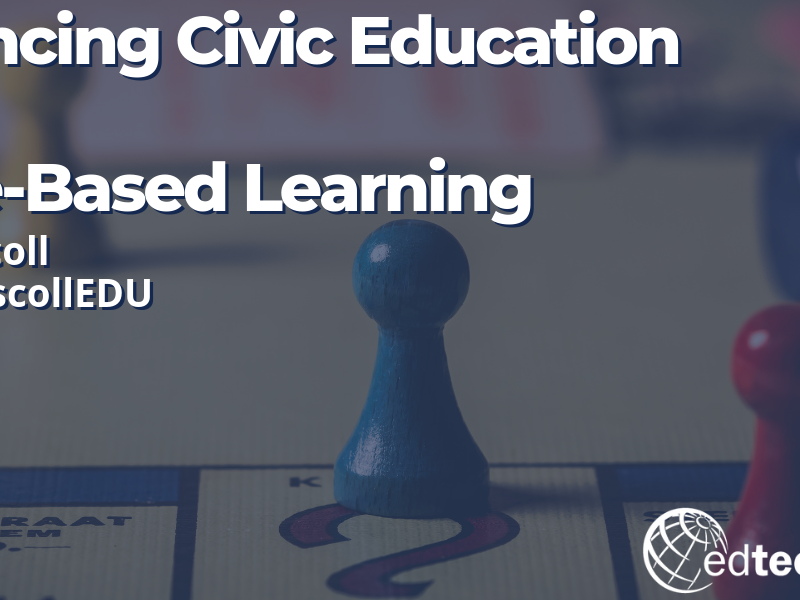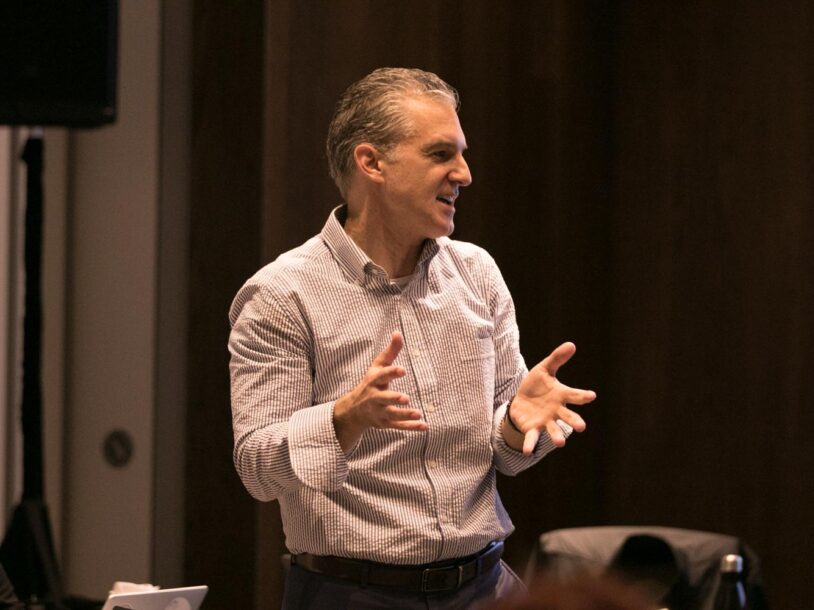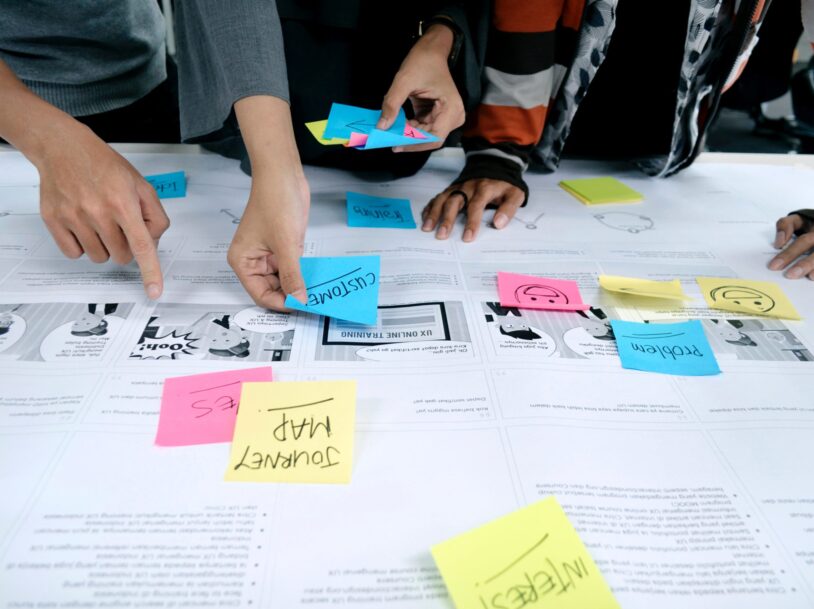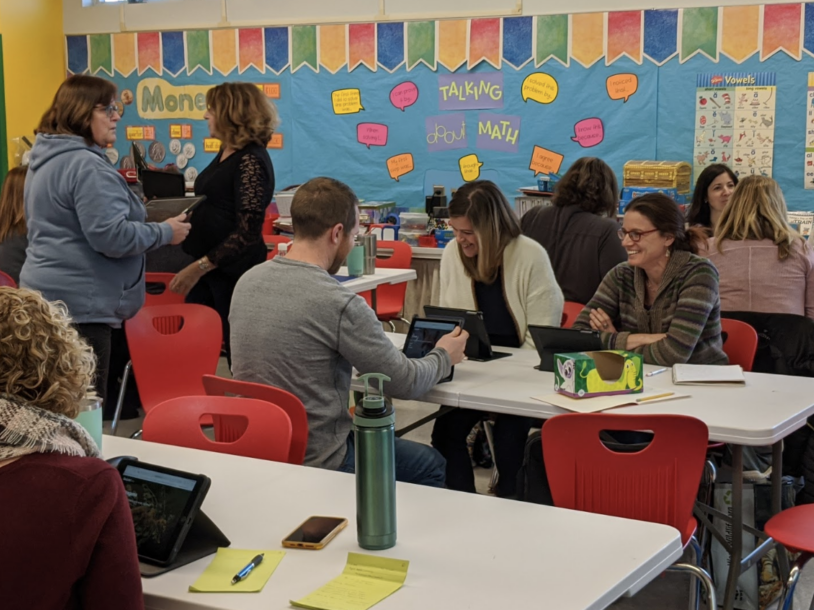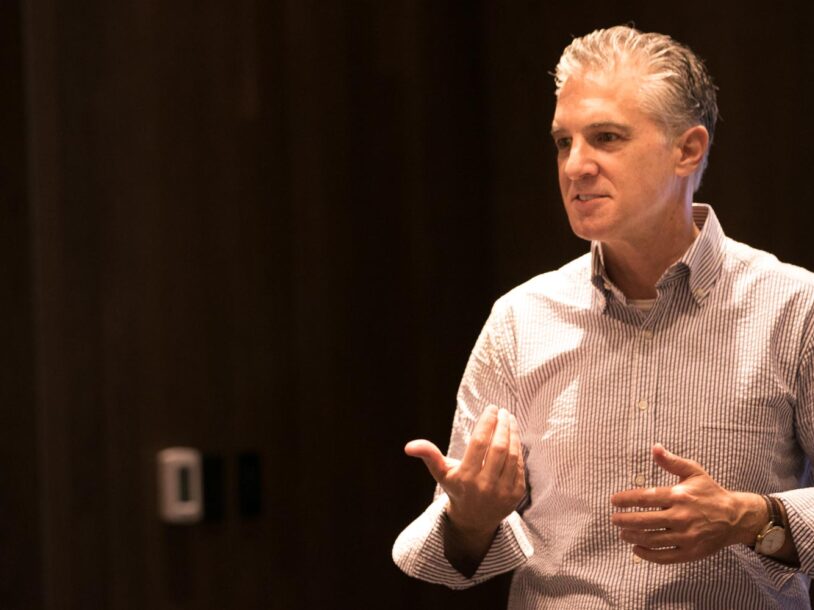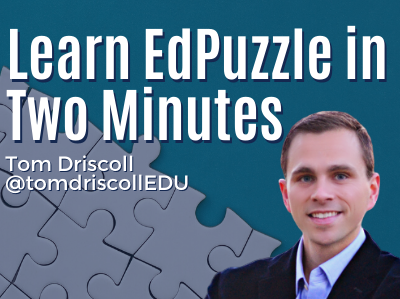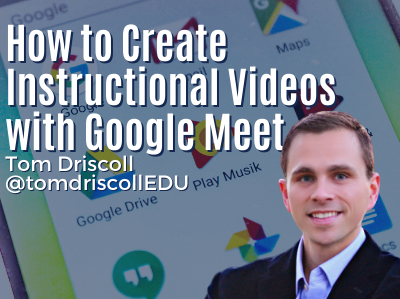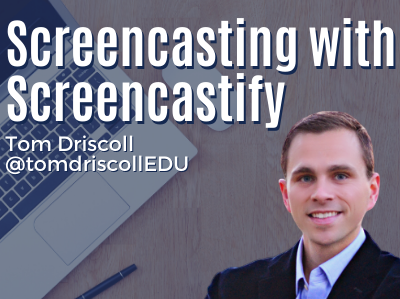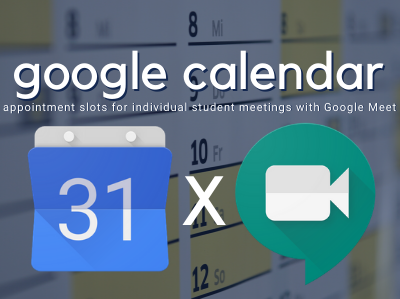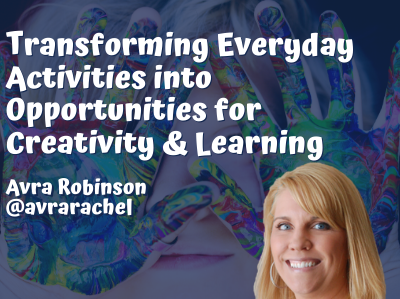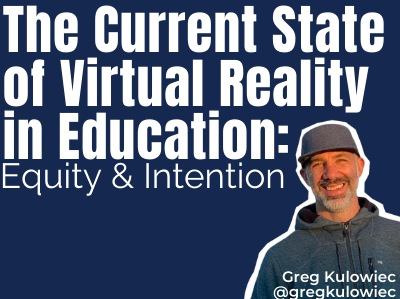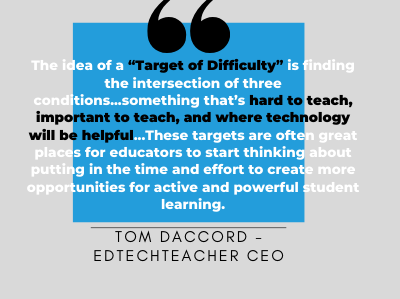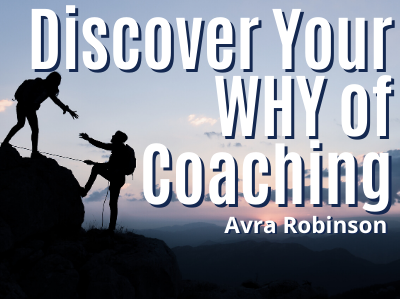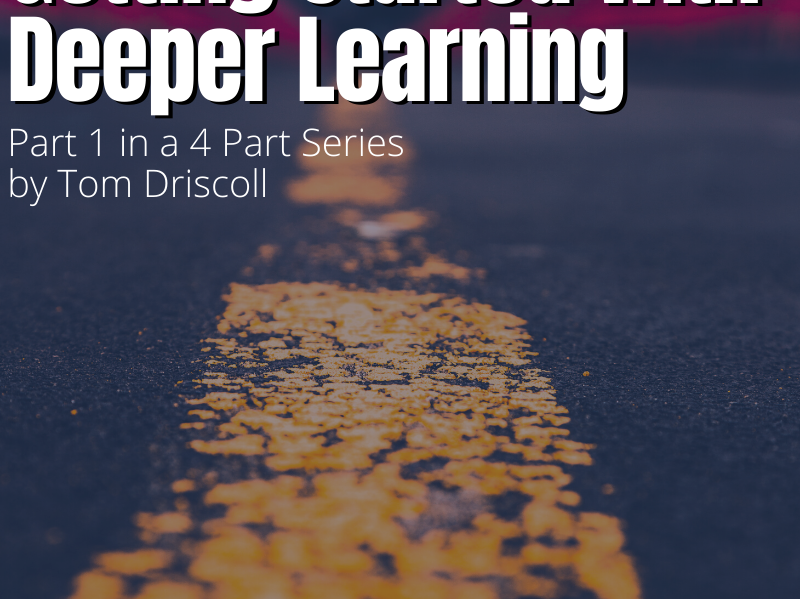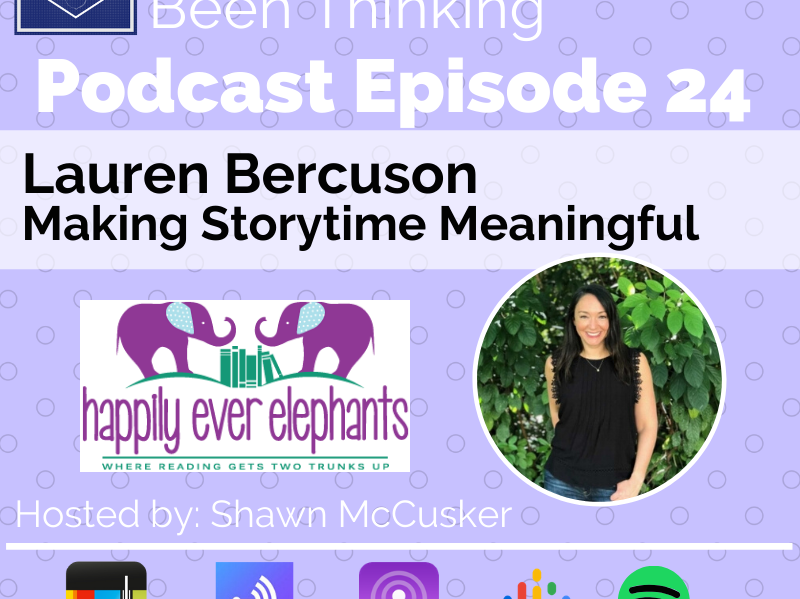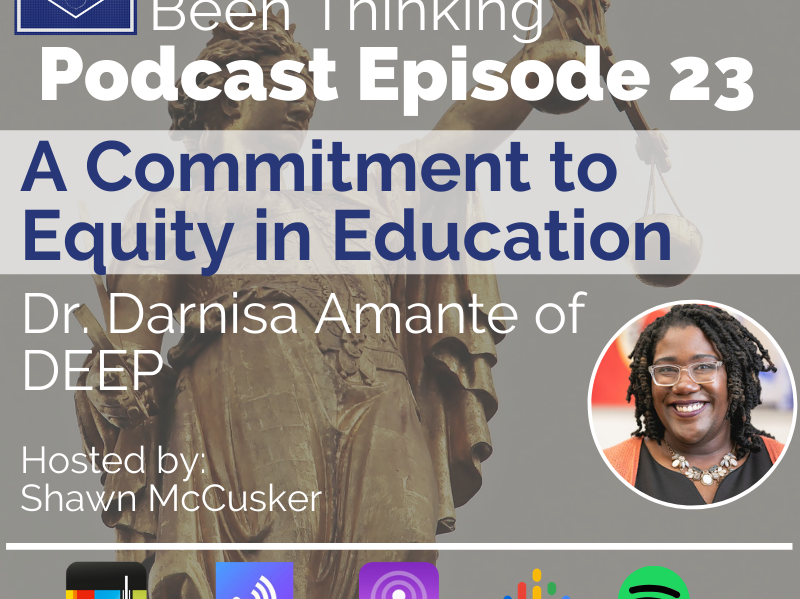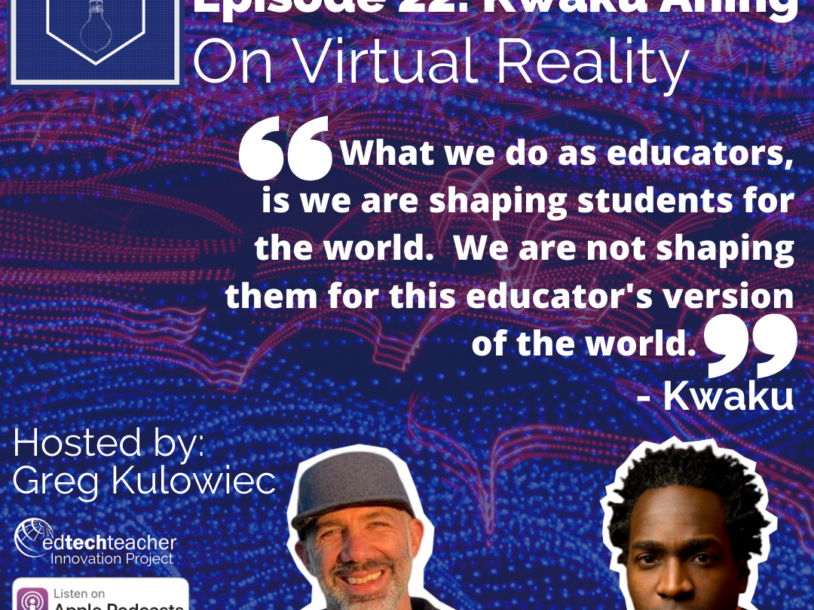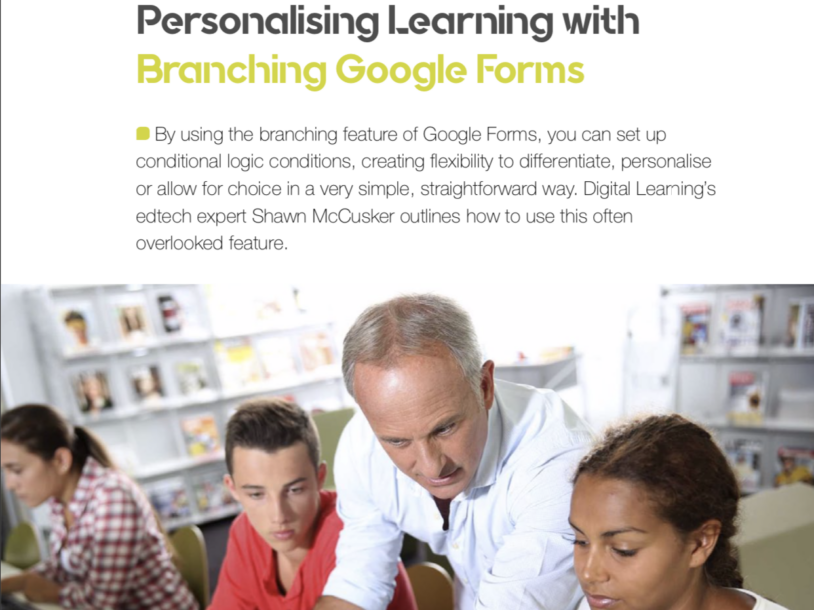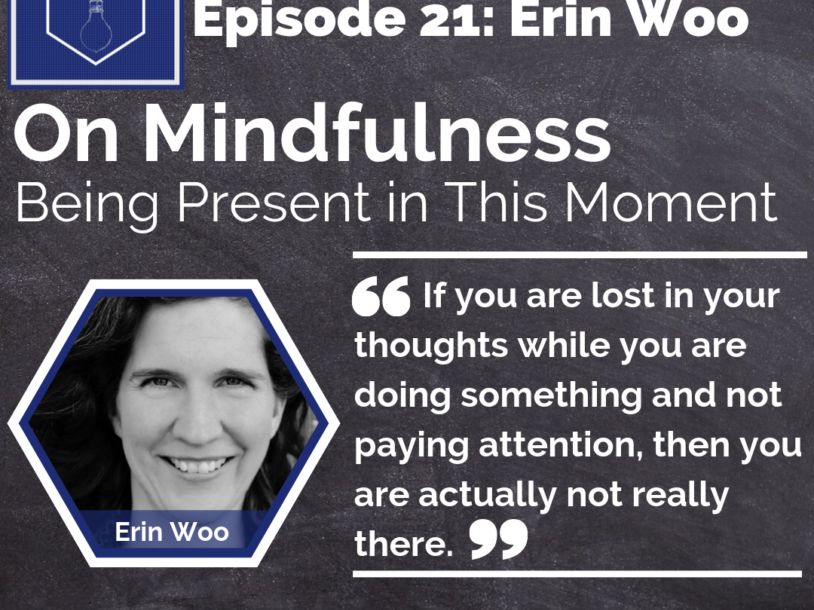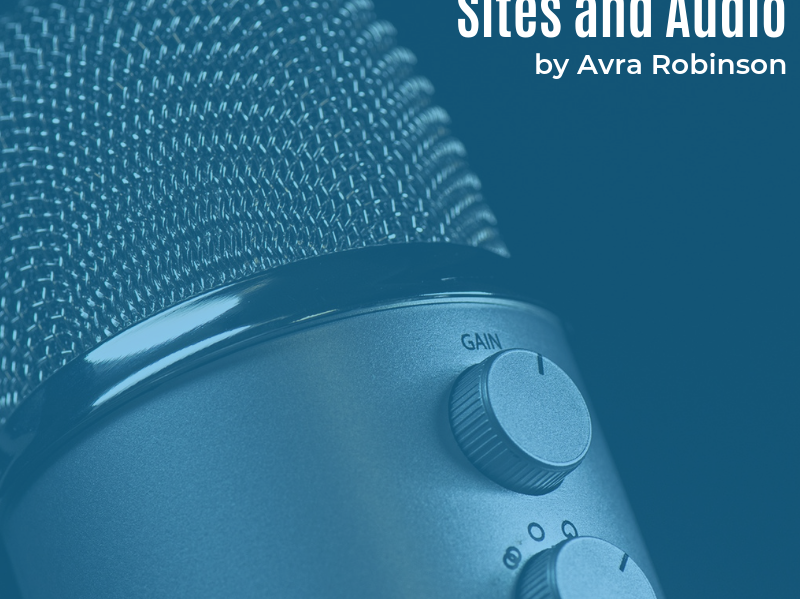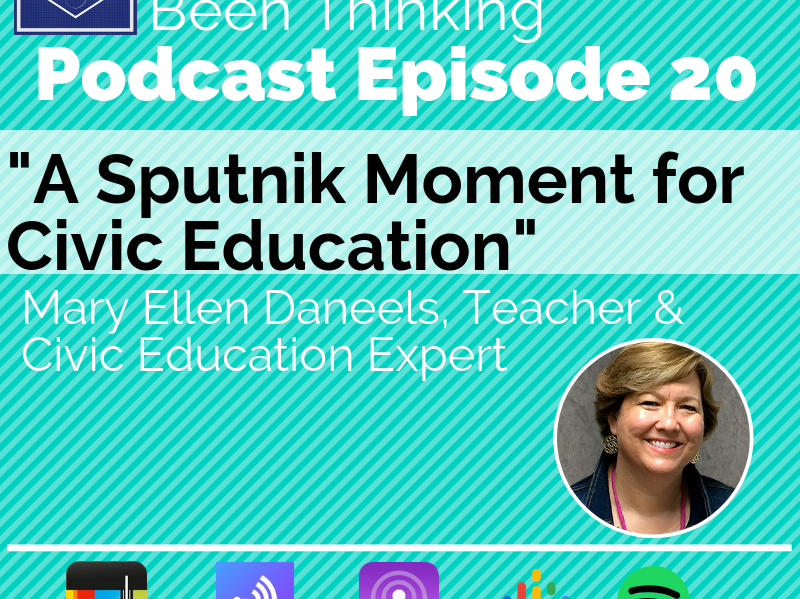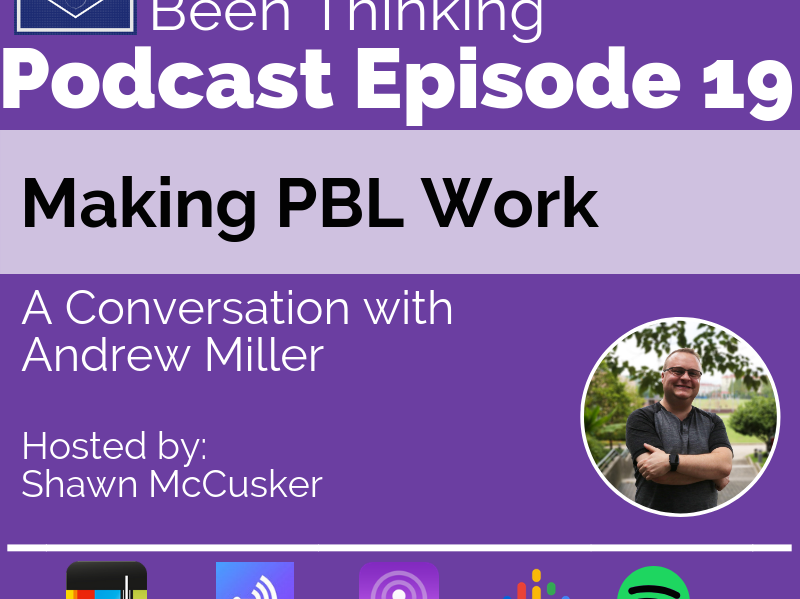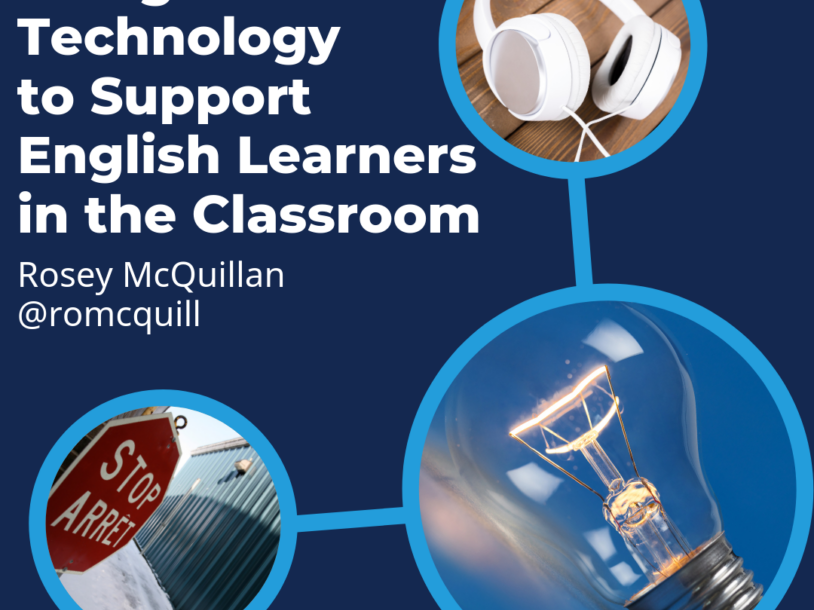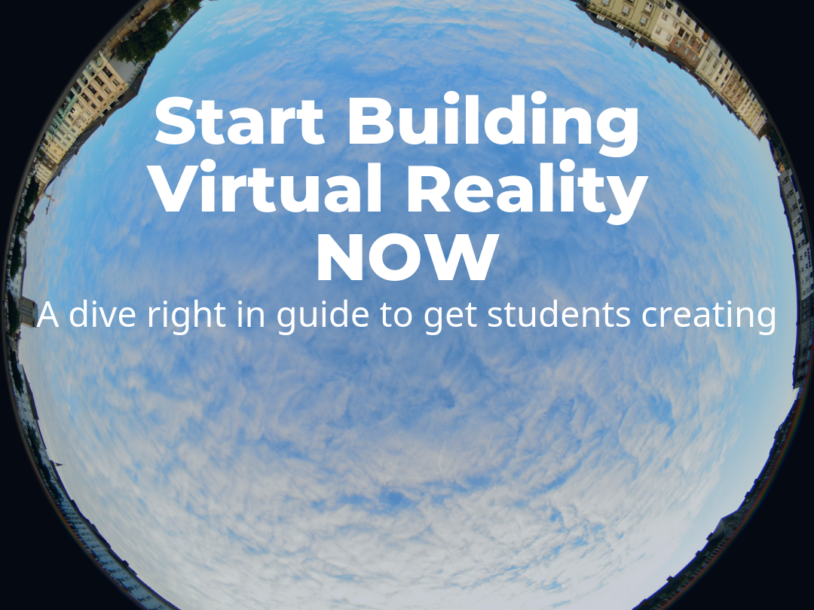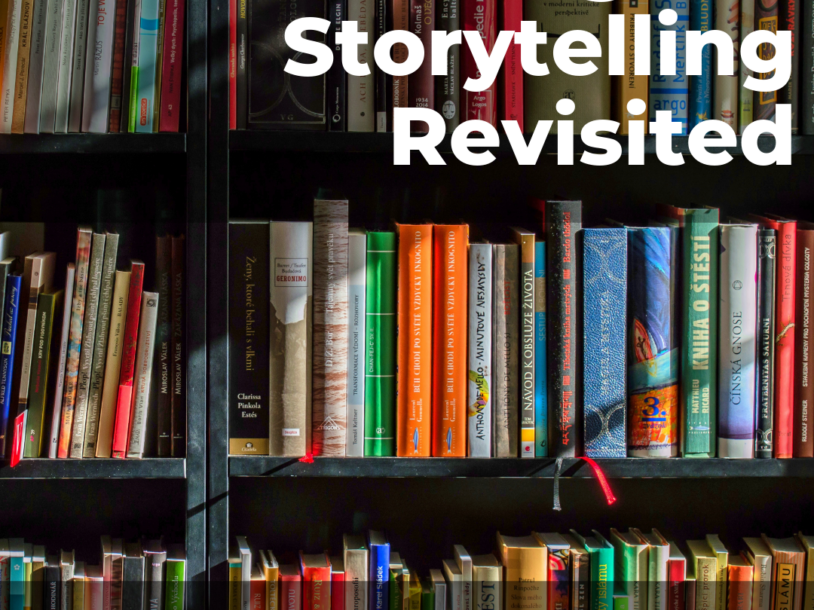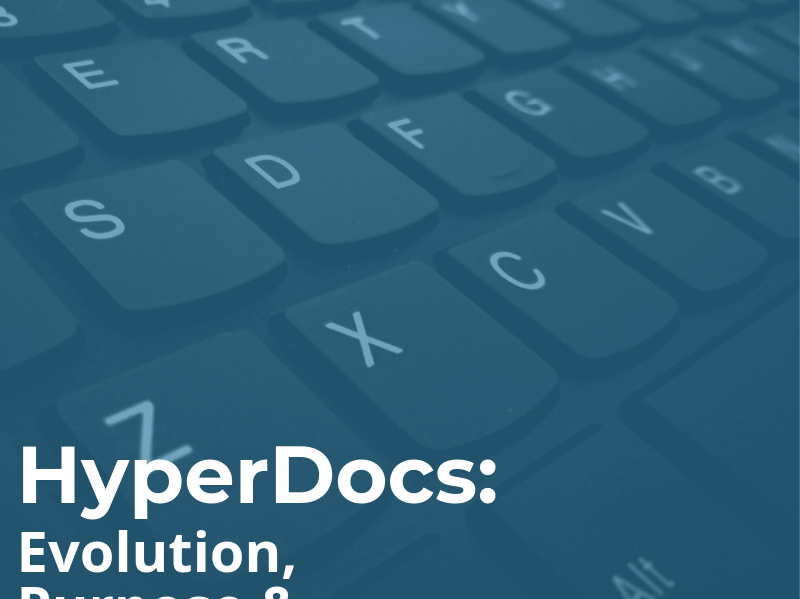The EdTechTeacher Blog
EdTech Resources & Strategies for Teachers
Subscribe to receive updates on our newest blog posts and resources!

- All
- Blog
- Deeper Learning
- Civics
- Design Thinking
- Project Based Learning
- AR VR
- Leadership
- Coaching
- Personalized Learning
- Featured
Evidence shows that when teachers have a practice that develops mindfulness and social-emotional capacities, it benefits their relationships with students, lowering states of anxiety, and increasing focus and ability to connect.
An excerpt from EdTechTeacher CEO Tom Daccord’s recent article in the Summer 2020 edition of Intrepid magazine, on COVID-19 school closures and the opportunity for pedagogical innovation.
This blog post originally appeared on Tom Driscoll EDU.We are experiencing a rising tide of advocacy for high quality civic education across the nation. There is also increasing interest and promising research around the impact that gamification can play in instructional design. Therefore, how might we leverage the power of gamification and game-based learning to enhance civic education? Why Simulations? Let’s start with a proven practice in civic education: student participation in simulations of democratic process and procedures. Providing students with opportunities to participate in civic practices is a powerful way to spark student engagement and deepen civic understanding. Doing…
Google Earth is a powerful, web-based tool that allows for students and teachers to explore the world, visualize data, develop critical thinking skills, and become creative communicators. Learn how to enhance the curriculum through Google Earth and other Google Geo resources.
The following post is an excerpt from EdTechTeacher CEO Tom Daccord’s blog, Leading Innovations in Schools: From Someday to Monday.
In this podcast episode, Tom Daccord and Caitlin McLemore discuss how assessment and grading are being redefined in an age of remote learning. Tom and Caitlin reconsider the balance of formative and summative assessment, reflect on the qualities of effective formative assessment, and explore several tools that can be used to create effective assessment strategies.
The following post is an excerpt from EdTechTeacher CEO Tom Daccord’s blog, Leading Innovations in Schools: From Someday to Monday.
In this post, EdTechTeacher Instructor Greg Kulowiec shares strategies for implementing the design thinking model in the classroom.
EdTechTeacher Instructor Tom Driscoll shares ideas for implementing project-based learning (PBL) at the elementary level, including tips for adapting project ideas in a remote learning environment.
The following post is an excerpt from EdTechTeacher CEO Tom Daccord’s blog, Leading Innovations in Schools: From Someday to Monday.
A Guest post by Dr. Courtney Pepe When reflecting upon the changing educational landscape that is taking place during Remote Learning, there are many challenges and dilemmas facing educators. Fortunately, educators are creative, dynamic and resourceful professionals who have the ability to turn challenges into opportunities. One notable challenge facing educators during Remote Learning is how to teach reading and literacy from a distance. The following literacy quote from author Kyleen Beers comes to mind ““Rigor is not an attribute of a text but rather a characteristic of our behavior with that text.” Educators all over the globe are creating…
An edtech gear post by Tom Driscoll Teachers across the world are attending virtual meetings, hosting live classes and creating instructional videos. When engaging in this new reality of teaching, you may have realized that your computer’s built-in microphone just isn’t cutting it. I realized this a while back when creating my first “flipped videos” and have tested out countless mic options over the years. Below are three great options for teachers looking to improve their sound quality, all without breaking the bank. Check them out and please feel free to reach out if you have any questions! ***Note: All…
A guest post by Dr. Courtney Pepe Our current educational system is now more dynamic and complex due to Covid-19. When reflecting upon the impact of Remote Learning and teacher practice, I often think of Rogers’ Law of Diffusion of Innovation, and the Three Car Train Concept of Ray Nashar. The three car train concept places educators into different train carriages based on their willingness to adopt an innovative mindset as it pertains to technology. There is a first car for those who embrace innovative technology, a second car for those who may need more support, and a third car…
A new video tutorial by Tom Driscoll Edpuzzle is an amazing platform that enables teachers to create interactive video lessons. In this tutorial, I demonstrate how to create an account, select a video, make it interactive (with questions and voiceovers) and assign it to your class. Here is the direct link to the video, also embedded below.
A new post & video tutorial by Tom Driscoll In my work with teachers around distance learning, I have been advocating for the creation of instructional videos that are tailored to their particular students. One of the simplest and most effective ways to get up and running with video creation is actually with Google Meet! Here is a quick tutorial I just created demonstrating the process in three steps:
A new post & video tutorial by Tom Driscoll Screencastify is one of the most popular screencasting tools for educators, and for good reason! It is a free Chrome extension that enables you to record your screen, add voiceover audio, and embed a webcam video. There are also some annotation and editing tools built-in. This is incredibly helpful for distance learning since it helps teachers provide students with much needed asynchronous video instruction that is tailored to their needs and interests. Here is a quick tutorial to help you get up and running with Screencastify!
Google Calendar Appointment Slots X Google Meet by Greg Kulowiec At a time when teachers and students are connecting remotely due to school closings, synchronous video check-ins are becoming an increasingly normal part of the school day. However, whole group meetings can be challenging for teachers to manage and might not allow for the individual connection that we are hoping to create with synchronous video. Fortunately, for schools that are using G Suite, Google Calendar and Google Meet, there is an embedded feature in Google Calendar that allows educators to create the opportunity for students to claim individual meeting slots.…
A post by Avra Robinson When I was a little girl, my parents constantly encouraged me to be creative during play. My mom and dad were both educators, and as such, they suggested constructive activities that rescued me from the inevitable boredom of the endless days of summer break. Now, as an educator looking back decades later, I realize that they were helping me take ordinary activities and discover ways to encourage creativity and learning through play. Everyday activities can be transformed into learning experiences in a variety of ways. Teachers and parents can design playful challenges and activities that…
A guest post by Maggie Brennan Below are helpful tips to teach effectively to maximize learning, keep the attention of all the students, and manage various problems. This article is especially useful for teachers with little experience in online learning environments. By now you have probably given a few live online classes and are settling into a routine of what to do and how to do it. Perhaps you have noticed that sometimes these classes work well and other times nothing goes right and you just want to give up. In either of those cases, keep in mind these helpful…
Webinar Archive: Audio & Video EdTechTeacher was proud to host a free roundtable discussion with educational leaders from across the country who provided perspectives on virtual teaching and learning in the face of extended school closings prompted by the coranavirus. The leaders discussed the challenges and opportunities posed by the swift transition to virtual learning environments and answered questions from the live audience. Listen or watch the entire archived discussion: Audio Archive: Video Archive: EdTechTeacher was joined by five accomplished school leaders who shared their experience, perspective, insight, and recommendations: Chris Lehmann – Principal & CEO at Science Leadership Academy, PennsylvaniaPatrick…
by: Tom Daccord A screencast is typically a short video recording of something transpiring on a computer screen or a mobile-device screen. It frequently includes audio narration and may also include text, music, images, and graphics. Screencasting can be helpful in nearly every curriculum and grade level as a useful means of providing opportunities for both teachers and students to communicate and share what they know, think, feel, and understand. Moreover, its video qualities engage a wide range of learners and the video can be paused and replayed to increase understanding and retention. Screencast videos can be uploaded to Google…
by Greg Kulowiec In these increasingly challenging times for educators, students and families, there has been an understandable focus placed on distance learning. While it is safe to say that this is not an ideal time to introduce new edtech tools to students, educators may want to consider the role that audio can play in enhancing communication with their students during prolonged school closures. While creating and sharing audio has been challenging and often problematic in the past, there are three approaches that educators can take, with very little background experience, to begin leveraging audio to connect with their students,…
by Tom Daccord As COVID-19 spreads in the U.S., schools and districts are looking for ways to administer remote learning in an effort to keep their community safe. To that end, we at EdTechTeacher have compiled a brief list of resources below: General information: Resources for K-12 Schools and Childcare Programs from the Center for Disease Control and Prevention (CDC).Includes a checklist for Teachers, Parents, and Administrators; FAQs for Administrators; Talking with Children About Corona Virus; and more. General EdTech: EdTech companies offering FREE support and/or access to schools affected by COVID19 closures.A growing collection of edtech companies that are…
by Greg Kulowiec It appears that there are countless options emerging, practically on a daily basis in the Virtual Reality space in education. Yet, there is also a clear disparity between the quality and equitable access to certain types of virtual reality experiences. At scale, schools that have access to virtual reality class kits for consumption are typically working with a Google Expeditions kit (or similar). Quite frequently, when I work with teachers with this setup, there are two problems that emerge: The devices (typically provisioned Android phones) either can’t get onto the school network or are not given access.The…
by: Thomas Daccord A few weeks ago I attended one of Greg Kulowiec’s Augmented Reality and Virtual Reality (ARVR) workshops in the Boston area. Greg did a wonderful job of highlighting ARVR’s educational benefits and I was struck in particular by VR’s implications for Social and Emotional Learning (SEL). Greg drew our attention to a project entitled Becoming Homeless: A Human Experience from the Stanford Virtual Human Interaction Lab. “Becoming Homeless” is a 7-minute VR experience where participants spend days in the life of a person who can no longer afford a home and interact with different environments in an…
A post by EdTechTeacher CEO Tom Daccord Recently I had a conversation with a school director of technology who was wondering how to help teachers identify “entry points” for innovation in their classroom. It made me think of conversations I had on this topic years ago with Dr. Justin Reich of the MIT Teaching Systems Lab in a run-up to a book we were writing together. One approach we both embrace is identifying a “Target of Difficulty.” The idea of a “Target of Difficulty” is finding the intersection of three conditions. First, teachers should seek out parts of their curriculum…
I’ve had the pleasure of working with a wide variety of people in my 24 years as an educator. As a classroom teacher, I always enjoyed collaborating with other teachers, learning from one another. It warmed my heart to teach a colleague something new, and I loved the support of other teachers as they shared new ideas with me. I think that it was the positive feeling of collaboration that led me to being a coach. As I’ve worked with many instructional and digital coaches over the past several years, I’ve not yet found one who went to college thinking,…
By Tom Driscoll (@TomDriscollEDU) I recently had the opportunity to work with an incredible group of elementary educators from Nauset Schools on Cape Cod. We capped off our PBL workshop by designing project sketches that the teachers would implement later this school year. They were so great, I asked the group if they could share their ideas. The teachers generously agreed, and below are their examples of inspiring yet practical examples of project based learning at the K-5 level! 1: Preparing for a Natural Disaster Driving Question How can we, as citizens of a coastal community, prepare for the effects…
Each environment, be it a jungle or a classroom, values certain behaviors and skills over others. So what does the classroom environment that effectively teaches these skills look like? For many, the answer is a classroom built upon the principles of Project Based Learning.
Personalized learning creates a variety of challenges for teachers. Understanding the tools that can support the creation of a personalized path for each student is a key part of making it work. The article focuses on an often overlooked feature in Google forms that can help teachers do just that.
Part 2 of the Deeper Learning Series Written by Tom Driscoll (@TomDriscollEDU) and Dr. Mario Andrade (@mariojandrade) This is the second post in a new 4-part EdTechTeacher series focused on Deeper Learning. Most of the current research and classroom innovation around deeper learning point to a recurring, if not central theme: authenticity and real-world experience. Let’s begin with a quick overview of these findings, then dive into practical resources and technologies that can help us enhance authentic experiences to deeper student learning. Scott McLeod (Different Schools for a Different World 2018) One of the “Four Big Shifts” that Scott McLeod…
Use Immersive Reader on Websites (unofficial) Chrome Extension Technology tools can make accessibility possible by creating embedded supports that differentiate and personalize instruction. The Google Suite has many built-in tools to support students’ reading, writing, and fluency. Extensions for Google Chrome can customize the browsing experience for users. Microsoft’s suite of programs has several learning tools that create an accessible reading experience as well. One such tools is the Immersive Reader. At EdTechTeacher, many of the schools we work with utilize G Suite for EDU as their primary suite of tools. Until recently, I have not been able to find…
Part 1 of the Deeper Learning Series This is the first post in a new 4-part EdTechTeacher series focused on Deeper Learning. How might educators and school leaders design experiences that spark and sustain deeper student learning? As an unprecedented emphasis on deeper learning has developed across the nation, we are tackling this complex challenge with a new level of urgency. Fortunately, new research, frameworks, design resources and practical examples have emerged that can help all of us chart new paths in our own contexts. In this four part series, we will explore the highest quality research and practical resources…
Social Emotional Learning (SEL) is currently a popular focus for schools because evidence suggests that effective SEL improves academic learning. How can we best teach students skills like self-awareness, self- management, empathy, perspective taking and cooperation? Today’s guest is someone who combines her love of reading and knowledge of books to provide support to people trying to start conversations about challenging issues. Whether it’s diversity, mindfulness, diversity or dealing with trauma… she has a list for you. (Though, she also has lists about unicorns and outer space!) Lauren Bercuson shares her work with “Happily Ever Elephants” and how to make…
If Equity work is going to be meaningful, it requires more than just a passing commitment of time and energy, more than just inviting a speaker or distributing materials. It means that community as a whole is going to take a good hard look in the mirror. So what does an Equity process look like and what does it entail? Shawn talks about Equity in Education with Dr. Darnisa Amante of Disruptive Equity Education Project (DEEP)
Educator Kwaku Aning joins us in our first episode that explores the potential and role of virtual reality in education. The discussion covers the entire spectrum of the topic from big picture thinking about the role and impact of VR in the classroom and on student experience, to specific approaches towards implementation.
Have you ever used Google Slides to create images? Just like with Google Drawings, Slides has many tools that facilitate the creation of images. From textboxes to shape and line tools, as well as the ability to change the background or insert photos, Google Slides can be a fabulous tool for teachers to create images to be exported and used in other environments. When I want to create a single, stand-alone graphic or image, I tend to use Google Drawings, but when I want to create a batch of images that are similar – such as images with spelling or…
Personalized learning creates a variety of challenges for teachers. Understanding the tools that can support the creation of a personalized path for each student is a key part of making it work. The article focuses on an often overlooked feature in Google forms that can help teachers do just that.
In the first episode for season 2 of the podcast, Greg was able to connect with Erin Woo of the Mindfulness Center at Brown University. Erin shares her experience and insight into mindfulness that starts at the beginning with a clear understanding on what it truly means to be mindful. From taking a breath to better connect with an experience, to truly unlocking creative thinking and innovation, being mindful is an increasingly common topic of discussion, and for good reason. In a world that is full of limitless distraction, being present in each moment seems more important than ever. As…
Assessment, today there is an abundance of simple, effective and free ways to collect information for learning in your classroom. A new challenge that these tools confront us with is whether we are making the most of the formative assessment data that we collect. Are we using this information effectively to inform our choices about the learning opportunities that we provide for our students?”
Book Creator’s multimodal tools and supports can be used for both teachers and students to create content, demonstrate understanding while building in student voice and choice.
I’ve always enjoyed just sitting and talking to my students. Conversation is such a neat way to get to know and understand a student’s mind and heart. I love hearing their perspective on life, on our classroom, and on the concepts that we are exploring. Having worked with students from Kindergarten through college, I have discovered that taking the time to just listen to students TALK is one of a teacher’s greatest opportunities to help them learn. Recording audio is a wonderful way to take these conversations or student reflections and save them to be heard at a later time! …
Across the country, there is a renewed focus on laws and practices to promote quality civic education, geared toward preparing our students with the skills they need to be active participants in a democracy who are able to access and insert themselves into the democratic decision making process. Shawn talks with Mary Ellen Daneels about transforming Civic Education.
Civic education in the United States has been getting a lot of attention lately. Different than “Government” courses that focus on the structures of government, the goal of a Civics course is to prepare students to participate in democracy and to educate them about the rights and duties of citizenship. One of the driving forces behind the renewed interest in civic education is the changing nature of HOW participation in civic dialogue is now taking place in our society. While “shift happens,” history is often the story of how that shift disrupts traditional patterns of life. When horses were replaced…
Shawn Talks with Project Based Learning (PBL) Expert Andrew Miller. Some changes take more than just making a new lesson or building a new unit. These changes can require a whole new mindset or in some cases building a new classroom culture. Project based Learning is one of these changes. Andrew Miller has been sharing his PBL expertise around the world and stops by today to discuss “Making PBL Work”
Interactive digital activities in Google Slides or Google Drawings are quickly taking the place of paper and pencil activities. They are designed in such a way that students interact with text and images – moving (by dragging and dropping) objects to an appropriate location on a canvas to demonstrate understanding of concepts they’ve learned. As teachers design these activities, they often work to create a stack of moveable objects that can be accessed without the need to copy/paste or duplicate each time. For some students, the multistep commands of copying and pasting can become barriers to success. They require two…
We are experiencing a rising tide of advocacy for high quality civic education across the nation. There is also increasing interest and promising research around the impact that gamification can play in instructional design. Therefore, how might we leverage the power of gamification and game-based learning to enhance civic education? Why Simulations? Let’s start with a proven practice in civic education: student participation in simulations of democratic process and procedures. Providing students with opportunities to participate in civic practices is a powerful way to spark student engagement and deepen civic understanding. Doing so, however, can be quite challenging. The ability…
There is more to educational technology than having the tools and telling students to use them.Being thoughtful about the tasks we have students complete and the proper tools to help them express their learning. Monica Burns shares her expertise on how to prioritize learning and put “Tasks Before Apps.”
English Learners (ELs) come into our classrooms with a wide range of specific and unique needs for language development and content acquisition. They are children whose primary language is not English and who are learning English as a second language. English learners account for more than 9 percent of enrollment in grades K-12 in U.S. schools.¹ The integration of technology allows for great possibilities in meeting the needs of this diverse group of students while providing options for personalizing the user experience. There are many apps and edtech tools available today, but very few are made specifically for EL students.…
Technology has forever changed the way that History classes are taught. Once, not very long ago, history classes relied upon two key sources of information: the teacher and the textbook. Students read the textbook, and then the teachers shared their vast knowledge, usually through lecture. Research assignments were key, but they were limited by the resources that were present in the school library, and the reality was that those resources were often very limited in terms of scope and perspective. That is not what history classes look like today. Not even a little bit. Today the internet allows us to…
A dive right in guide to get students creating There is a lot of buzz around using Augmented and Virtual Reality technology in education, often as a technology on the horizon that is soon to emerge as a powerful classroom tool. The fact is, the tools are currently in place to get students started building with AR/ VR technology NOW and many of the best platforms just happen to be free. So if you are thinking of diving in but have been afraid to take the leap, here is a “Get Started NOW” guide to have students building and sharing…
Storytelling has always been a significant part of education. In learning to tell stories, students explore sequencing, descriptive language, writing, fluency, adding details, and much more. The act of being able to tell and write a cohesive story is a critical communication skill for all students to develop. In addition to telling stories, there is great value in having students illustrate their concepts. While this can certainly be achieved on paper, by exploring digital storytelling tools, students can expand their audience of readers, more easily edit their work, add their own voice recordings for narration, and even collaborate. Stories bring…
In episode 17, Greg sat down with David Lee to dig into Design Thinking. The discussion shifts from the model itself to the importance of shifting culture and mindsets to truly leverage the design thinking process. David is an EdTech Specialist at Singapore American School and the author of Design Thinking in the Classroom. Learn more about his work at his site, David Lee EdTech and follow along with David’s work on Instagram & Twitter.
by Tom Driscoll A core element of personalized learning involves tailoring students’ path and pace to their specific needs and interests. This practice is often coupled with the overarching philosophy of mastery learning, sometimes referred to as competency-based education. One of the most effective ways to personalize the path and pace of student learning is to build a strong foundation of competency based learning in your classroom or institution. Schools that have a strong grasp of student competencies and learning targets, along with clear protocols for students to demonstrate mastery of these competencies, have had much success in designing personalized…
As educators, we innately know that our students bring different learner profiles to our classrooms. We are constantly faced with the task of helping students stay engaged, show growth, and master the curriculum. Differentiated instruction is a method by which we can tackle this challenge and find new ways to help our students. It focuses on utilizing teaching strategies that provide students with multiple options for taking in and processing information, making sense of ideas, and then expressing their learning. It is the process by which teachers utilize a variety of tools and strategies to meet the needs of their…
Moving from an analog environment to a digital one has never been more important or easier. It can be challenging to design learning experiences which allow students voice and choice while providing opportunities to support diverse learning styles. Digital differentiation using G-Suite allows information to be presented in multiple ways and encourages students to take ownership of their learning. Join Rosey McQuillan and Avra Robinson as they explore a wide variety of strategies to enhance student access, provide for differentiation, and increase student productivity with G Suite for EDU. If digital differentiation with technology and G Suite is a concept…
Civic engagement has been a foundational element of our nation since its inception. But it is undeniable that the rapid shifts in our world have also shifted what civic engagement means and looks like. These changes have created exciting new opportunities to learn, connect and engage with others, yet have also surfaced new challenges in navigating our complex, hyperconnected and rapidly changing world. These shifts also have a profound impact on education. Since one of the historical roles of public education is to prepare students for their role in our democratic society, a shift in civic engagement invariably means…
Why Design Thinking? How Might We Create meaningful learning environments for students? This is a huge question to tackle and one with countless reasonable answers. Whether classrooms embrace Project Based Learning, Inquiry Based Instruction, Personalized Learning, or another other framework for a classroom experience, the intention tends to be universal. Educators want to create the most meaningful environment that allows for students to explore new ideas, learn essential skills and content, and demonstrate their understanding. Add into that equation student collaboration, creativity, and connections to real world problems, and we have a steep mountain to climb. Design Thinking has emerged…
The Evolution of Google Drive & HyperDocs If there is an edtech tool that is constantly evolving, updating, and providing more opportunity for student creation & collaboration than G Suite I have yet to see it. While educational technology is a constantly changing landscape, the G Suite, and Google Drive platform has been a constant and has evolved with a focus on effective and meaningful use in the classroom. When G Suite for EDU first emerged as a tool that could potentially be used in an educational setting, there was limited functionality, digital workflow was challenging, collaboration was a…
Our ServicesWhat We DoAI in Education PDSummer WorkshopsWorkshops and KeynotesFull Year & Custom PDIT & Audit ServicesGoogle TrainingMicrosoft TrainingAdobe TrainingInstructional CoachingApp RecommendationsAI CourseAI in Edu SummitBlogPartnershipsAbout Us Our ServicesWhat We DoAI in Education PDSummer WorkshopsWorkshops and KeynotesFull Year & Custom PDIT & Audit ServicesGoogle TrainingMicrosoft TrainingAdobe TrainingInstructional CoachingApp RecommendationsAI CourseAI in Edu SummitBlogPartnershipsAbout UsCONTACT USThe EdTechTeacher BlogEdTech Resources & Strategies for TeachersSubscribe to receive updates on our newest blog posts and resources! SIGN UP TODAY! All Blog Deeper Learning Civics Google Design Thinking Project Based Learning AR VR Leadership Coaching Personalized Learning Featured How Online Mindfulness Fuels Teacher Collaboration &…



